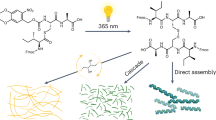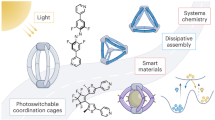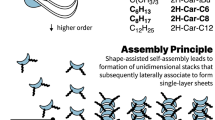Abstract
The self-assembly of chemical entities represents a very attractive way to create a large variety of ordered functional structures and complex matter. Although much effort has been devoted to the preparation of supramolecular nanostructures based on different chemical building blocks, an understanding of the mechanisms at play and the ability to monitor assembly processes and, in turn, control them are often elusive, which precludes a deep and comprehensive control of the final structures. Here the complex supramolecular landscape of a platinum(II) compound is characterized fully and controlled successfully through a combination of supramolecular and photochemical approaches. The supramolecular assemblies comprise two kinetic assemblies and their thermodynamic counterpart. The monitoring of the different emission properties of the aggregates, used as a fingerprint for each species, allows the real-time visualization of the evolving self-assemblies. The control of multiple supramolecular pathways will help the design of complex systems in and out of their thermodynamic equilibrium.
This is a preview of subscription content, access via your institution
Access options
Subscribe to this journal
Receive 12 print issues and online access
$259.00 per year
only $21.58 per issue
Buy this article
- Purchase on Springer Link
- Instant access to full article PDF
Prices may be subject to local taxes which are calculated during checkout




Similar content being viewed by others
References
Lehn, J.-M. Toward self-organization and complex matter. Science 295, 2400–2403 (2002).
Reinhoudt, D. N. & Crego-Calama, M. Synthesis beyond the molecule. Science 295, 2403–2407 (2002).
Whitesides, G. M., Mathias, J. P. & Seto, C. T. Molecular self-assembly and nanochemistry: a chemical strategy for the synthesis of nanostructures. Science 254, 1312–1319 (1991).
Aida, T., Meijer, E. W. & Stupp, S. I. Functional supramolecular polymers. Science 335, 813–817 (2012).
Whitesides, G. M. & Boncheva, M. Beyond molecules: self-assembly of mesoscopic and macroscopic components. Proc. Natl Acad. Sci. USA 99, 4769–4774 (2002).
Jonkheijm, P., van der Schoot, P., Schenning, A. P. H. J. & Meijer, E. W. Probing the solvent-assisted nucleation pathway in chemical self-assembly. Science 313, 80–83 (2006).
Lehn, J.-M. Toward complex matter: supramolecular chemistry and self-organization. Proc. Natl Acad. Sci. USA 99, 4763–4768 (2002).
Lehn, J.-M. Supramolecular chemistry—scope and perspectives. Molecules, supermolecules, and molecular devices. Angew. Chem. Int. Ed. 27, 89–117 (1988).
Lehn, J.-M. Perspectives in supramolecular chemistry—from molecular recognition towards molecular information processing and self-organization. Angew. Chem. Int. Ed. 29, 1304–1319 (1990).
Busseron, E., Ruff, Y., Moulin, E. & Giuseppone, N. Supramolecular self-assemblies as functional nanomaterials. Nanoscale 5, 7098–7140 (2013).
Mai, Y. & Eisenberg, A. Self-assembly of block copolymers. Chem. Soc. Rev. 41, 5969–5985 (2012).
Korevaar, P. A., Newcomb, C. J., Meijer, E. W. & Stupp, S. I. Pathway selection in peptide amphiphile assembly. J. Am. Chem. Soc. 136, 8540–8543 (2014).
Rodríguez-Llansola, F. & Meijer, E. W. Supramolecular autoregulation. J. Am. Chem. Soc. 135, 6549–6553 (2013).
Lohr, A., Lysetska, M. & Würthner, F. Supramolecular stereomutation in kinetic and thermodynamic self-assembly of helical merocyanine dye nanorods. Angew. Chem. Int. Ed. 44, 5071–5074 (2005).
Cui, H., Chen, Z., Zhong, S., Wooley, K. L. & Pochan, D. J. Block copolymer assembly via kinetic control. Science 317, 647–650 (2007).
Korevaar, P. A. et al. Pathway complexity in supramolecular polymerization. Nature 481, 492–496 (2012).
Ogi, S., Sugiyasu, K., Manna, S., Samitsu, S. & Takeuchi, M. Living supramolecular polymerization realized through a biomimetic approach. Nature Chem. 6, 188–195 (2014).
Powers, E. T. & Powers, D. L. Mechanisms of protein fibril formation: nucleated polymerization with competing off-pathway aggregation. Biophys. J. 94, 379–391 (2008).
Strassert, C. A. et al. Switching on luminescence by the self-assembly of a platinum(II) complex into gelating nanofibers and electroluminescent films. Angew. Chem. Int. Ed. 50, 946–950 (2011).
Mauro, M. et al. Self-assembly of a neutral platinum(II) complex into highly emitting microcrystalline fibers through metallophilic interactions. Chem. Commun. 50, 7269–7272 (2014).
Yam, V. W.-W., Wong, K. M.-C. & Zhu, N. Solvent-induced aggregation through metal···metal/π···π interactions: large solvatochromism of luminescent organoplatinum(II) terpyridyl complexes. J. Am. Chem. Soc. 124, 6506–6507 (2002).
Ma, B. et al. Synthetic control of Pt···Pt separation and photophysics of binuclear platinum complexes. J. Am. Chem. Soc. 127, 28–29 (2005).
Po, C., Tam, A. Y.-Y., Wong, K. M.-C. & Yam, V. W.-W. Supramolecular self-assembly of amphiphilic anionic platinum(II) complexes: a correlation between spectroscopic and morphological properties. J. Am. Chem. Soc. 133, 12136–12143 (2011).
Krikorian, M., Liu, S. & Swager, T. M. Columnar liquid crystallinity and mechanochromism in cationic platinum(II) complexes. J. Am. Chem. Soc. 136, 2952–2955 (2014).
Aliprandi, A., Genovese, D., Mauro, M. & De Cola, L. Recent advances in phosphorescent Pt(II) complexes featuring metallophilic interactions: properties and applications. Chem. Lett. 44, 1152–1169 (2015).
Åkerlöf, G. & Short, O. A. The dielectric constant of dioxane–water mixtures between 0 and 80°. J. Am. Chem. Soc. 58, 1241–1243 (1936).
Hovorka, F., Schaefer, R. A. & Dreisbach, D. The system dioxane and water. J. Am. Chem. Soc. 58, 2264–2267 (1936).
Johnsson, K. et al. A near-infrared fluorophore for live-cell super-resolution microscopy of cellular proteins. Nature Chem. 5, 132–139 (2013).
Filot, I. A. W. et al. Understanding cooperativity in hydrogen-bond-induced supramolecular polymerization: a density functional theory study. J. Phys. Chem. B 114, 13667–13674 (2010).
Korevaar, P. A., Schaefer, C., de Greef, T. F. A. & Meijer, E. W. Controlling chemical self-assembly by solvent-dependent dynamics. J. Am. Chem. Soc. 134, 13482–13491 (2012).
ten Eikelder, H. M. M., Markvoort, A. J., de Greef, T. F. A. & Hilbers, P. A. J. An equilibrium model for chiral amplification in supramolecular polymers. J. Phys. Chem. B 116, 5291–5301 (2012).
Carnall, J. M. A. et al. Mechanosensitive self-replication driven by self-organization. Science 327, 1502–1506 (2010).
Nguyen, R., Allouche, L., Buhler, E. & Giuseppone, N. Dynamic combinatorial evolution within self-replicating supramolecular assemblies. Angew. Chem. Int. Ed. 48, 1093–1096 (2009).
Bachmann, P. A., Luisi, P. L. & Lang, J. Autocatalytic self-replicating micelles as models for prebiotic structures. Nature 357, 57–59 (1992).
Morris, A. M., Watzky, M. A. & Finke, R. G. Protein aggregation kinetics, mechanism, and curve-fitting: a review of the literature. Biochim. Biophys. Acta 1794, 375–397 (2009).
Zhao, D. & Moore, J. S. Nucleation–elongation: a mechanism for cooperative supramolecular polymerization. Org. Biomol. Chem. 1, 3471–3491 (2003).
Baskakov, V., Legname, G., Baldwin, M. A., Prusiner, S. B. & Cohen, F. E. Pathway complexity of prion protein assembly into amyloid. J. Biol. Chem. 277, 21140–21148 (2002).
Hudson, Z. M. et al. Tailored hierarchical micelle architectures using living crystallization-driven self-assembly in two dimensions. Nature Chem. 6, 893–898 (2014).
Rupar, P. A., Chabanne, L., Winnik, M. A. & Manners, I. Non-centrosymmetric cylindrical micelles by unidirectional growth. Science 337, 559–562 (2012).
Gilroy, J. B. et al. Monodisperse cylindrical micelles by crystallization-driven living self-assembly. Nature Chem. 2, 566–570 (2010).
Odian, G. Principles of Polymerization 4th edn (Wiley, 2004).
Acknowledgements
We thank the University of Strasbourg and the CNRS for financial support. L.D.C. is grateful to the Région Alsace and the Communauté Urbaine de Strasbourg for the award of a Gutenberg Excellence Chair (2011–2012) and to AXA Research funds. We gratefully acknowledge the Fondation CIRFC (Université de Strasbourg), the Région Alsace, the Communauté Urbaine de Strasbourg, the Département du Bas-Rhin and the Ministère de l'Enseignement Supérieur de la Recherche for funding the purchase of the confocal microscope. P. Samorí is gratefully acknowledged for the use of the temperature-dependent UV-vis spectrophotometer. We thank L. Maggini for SEM images, D. Septiady for some help with the confocal microscope and D. Genovese for helpful discussions. E. W. Meijer is gratefully acknowledged for enlightening discussions.
Author information
Authors and Affiliations
Contributions
The synthesis was performed by A.A., spectroscopic and confocal microscopy experiments were designed, realized and interpreted by A.A. under the supervision of M.M. and L.D.C., and A.A., M.M. and L.D.C. wrote the paper.
Corresponding authors
Ethics declarations
Competing interests
The authors declare no competing financial interests.
Supplementary information
Supplementary information
Supplementary information (PDF 1135 kb)
Supplementary information
Supplementary Movie 1 (AVI 92823 kb)
Supplementary information
Supplementary Movie 2 (AVI 92840 kb)
Supplementary information
Supplementary Movie 3 (AVI 77204 kb)
Supplementary information
Supplementary Movie 4 (AVI 2341 kb)
Rights and permissions
About this article
Cite this article
Aliprandi, A., Mauro, M. & De Cola, L. Controlling and imaging biomimetic self-assembly. Nature Chem 8, 10–15 (2016). https://doi.org/10.1038/nchem.2383
Received:
Accepted:
Published:
Issue Date:
DOI: https://doi.org/10.1038/nchem.2383
This article is cited by
-
Using synthesis to steer excited states and their properties and functions
Nature Synthesis (2023)
-
Bioinspired crowding directs supramolecular polymerisation
Nature Communications (2023)
-
A dynamic assembly-induced emissive system for advanced information encryption with time-dependent security
Nature Communications (2022)
-
Molecular communications in complex systems of dynamic supramolecular polymers
Nature Communications (2022)
-
Amplified circularly polarized luminescence promoted by hierarchical self-assembly involving Pt···Pt interactions
Science China Materials (2022)



